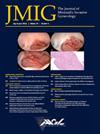腹腔镜手术治疗间质部异位妊娠:逆行挤奶技术
IF 3.5
2区 医学
Q1 OBSTETRICS & GYNECOLOGY
引用次数: 0
摘要
研究目的回顾间质异位妊娠(IEP)的分类和手术治疗方案,并展示一种治疗远端IEP的新方法--保全子宫肌层的腹腔镜逆行挤奶技术。患者被置于背侧截石位,双腿蹬地,双臂内收。干预措施采用腹腔镜逆行挤奶技术将妊娠挤入输卵管安瓿,该技术是治疗远端IEP的新兴技术,可避免子宫肌层切口。随后进行了常规输卵管切除术。每周对她的β-HCG进行随访,直到阴性为止。结论腹腔镜逆行挤奶技术可以安全有效地处理远端IEPs,然后进行常规输卵管切除术。由于存在术中破裂的风险,外科医生的技术对于 IEPs 的手术治疗仍然至关重要。实施挤奶技术的医生应准备好将手术紧急转换为粟粒状造口术或楔形切除术,并熟练掌握腹腔镜缝合技术。如果使用挤奶技术可以避免子宫肌层切口,其优点可能包括缩短手术时间、减少失血、更快恢复,以及避免子宫肌层切口而可能在后续妊娠中进行阴道分娩,而在腹腔镜隅角切开术或隅角楔形切除术后,通常不建议进行阴道分娩。虽然理论上这种技术不会破坏子宫肌层,但在使用这种技术进行输卵管切除术后的试产过程中,应告知患者有关子宫破裂风险的证据不足。本文章由计算机程序翻译,如有差异,请以英文原文为准。
Laparoscopic Surgical Management of Interstitial Ectopic Pregnancy: The Retrograde Milking Technique
Study Objective
To review the classification and surgical management options for interstitial ectopic pregnancy (IEP) and demonstrate a novel approach to the management of distal IEP, the myometrium-sparing laparoscopic retrograde milking technique.
Design
One patient underwent surgical management of distal IEP using the laparoscopic retrograde milking technique followed by routine salpingectomy. She was seen for routine 6-week postoperative follow-up.
Setting
The patient was positioned in dorsal lithotomy with legs in stirrups and arms tucked. A 10mm 30-degree laparoscope and three 5-mm accessory ports were used.
Patients or Participants
One patient with distal IEP was selected and provided informed consent for video recording of her surgery to be used for educational and research purposes.
Interventions
The laparoscopic retrograde milking technique, an emerging technique for management of distal IEP that avoids myometrial incision, was used to milk the pregnancy into the tubal ampulla. Routine salpingectomy was then performed.
Measurements and Main Results
The patient had an uncomplicated surgery and recovery. Her beta-HCG was followed weekly until negative.
Conclusion
Distal IEPs may be safely and effectively managed with the laparoscopic retrograde milking technique followed by routine salpingectomy. Surgeon skill remains paramount to the surgical management of IEPs due to the risk of intraoperative rupture. Providers performing the milking technique should be prepared to urgently convert the procedure to a cornuostomy or wedge resection and be comfortable with laparoscopic suturing. If myometrial incision can be avoided through use of the milking technique, advantages may include reduced operative time, decreased blood loss, faster recovery, and the possibility of vaginal delivery in subsequent pregnancies by avoiding a myometrial incision, an option typically not recommended after laparoscopic cornuostomy or cornual wedge resection. Although theoretically this technique does not breach the myometrium, patients should be counselled about the lack of evidence regarding risk of uterine rupture during trial of labour after salpingectomy using this technique.
求助全文
通过发布文献求助,成功后即可免费获取论文全文。
去求助
来源期刊
CiteScore
5.00
自引率
7.30%
发文量
272
审稿时长
37 days
期刊介绍:
The Journal of Minimally Invasive Gynecology, formerly titled The Journal of the American Association of Gynecologic Laparoscopists, is an international clinical forum for the exchange and dissemination of ideas, findings and techniques relevant to gynecologic endoscopy and other minimally invasive procedures. The Journal, which presents research, clinical opinions and case reports from the brightest minds in gynecologic surgery, is an authoritative source informing practicing physicians of the latest, cutting-edge developments occurring in this emerging field.

 求助内容:
求助内容: 应助结果提醒方式:
应助结果提醒方式:


